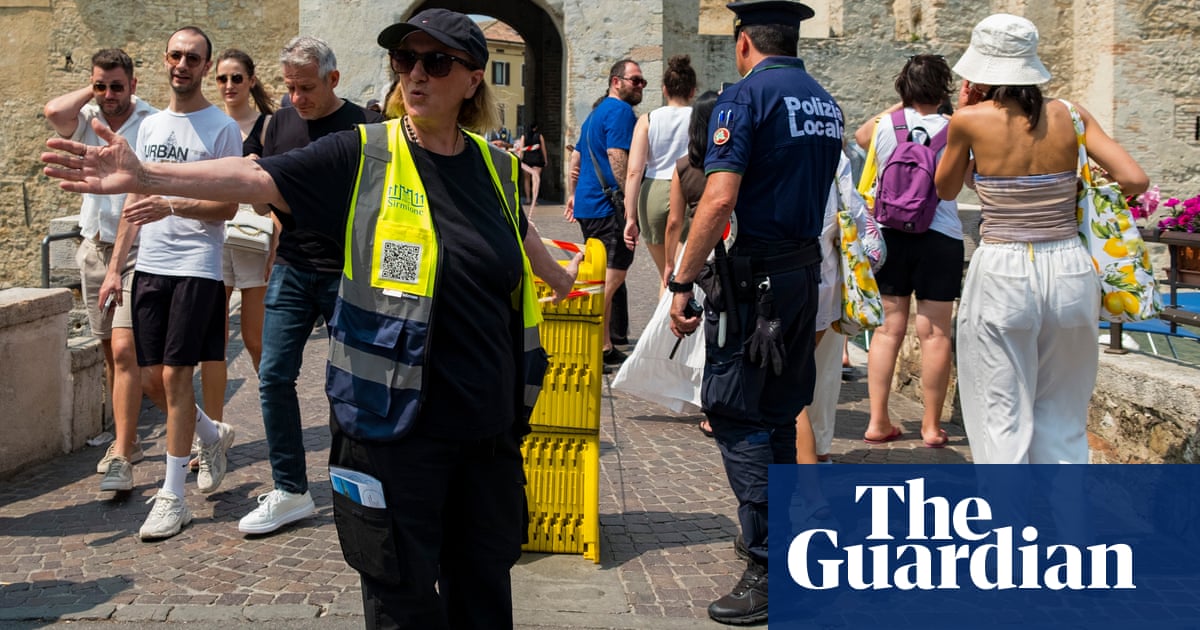In the era of overtourism, every popular holiday destination has its tipping point.
For Sirmione, a sliver of land lapped by the blue-green waters of Lake Garda, that watershed moment came during Italy’s long May Day holiday weekend, and has led the medieval Italian village to introduce “street tutors” to manage the visitor flow and ensure good behaviour.
The village, considered a pearl in Lombardy’s lake district, was caught off-guardon 2 Maywhen a crowd of people became jammed as they endeavoured to walk over its tiny stone bridge, which once served as a drawbridge, and into its warren of narrow lanes.
What should have been a pleasant day spent visiting Sirmione’s 14th-century castle or the villa where the legendary opera singer Maria Callas lived, followed perhaps byspaghetti alle vongoleand an afternoon nap on a lake-side beach, quickly spiralled into sheer torment for the tourists and 200 or so year-round inhabitants.
There were queues of up to 40 minutes simply to walk across the bridge – a journey that would ordinarily take about 10 seconds – as pedestrians jostled with cars, many transporting well-heeled guests to their hotels.
Images and videos of the chaotic scenes were shared on social media, catapulting Sirmione, which already tops the list of Lake Garda’s most-visited locations, into the centre of Italy’s overtourism debate.
“The bridge was completely blocked,” said Cristina Fontana, who commutes by foot to her job at a newsagents. “I managed to get to work on time early in the morning, but it took me a while to get home. We survive off tourism, but this was an exceptional day.”
Luisa Lavelli, the mayor of Sirmione, said the bridge was soon de-congested and the mayhem eased, but with tempers flaring and criticism raining down on her council, she had to move swiftly to come up with solutions to prevent the village from buckling under the weight of its visitors.
Sirmione attracts an average 1.3 million tourists a year. That figure, however, does not include day-trippers. During the fraught May Day holiday, an estimated 45,000 more visited compared with the same period in 2024.
Lavelli’s administration thrashed out possible solutions to an increasingly challenging dilemma. They ruled out extreme measures, such as putting a cap on visitor numbers or following in the footstepsof Veniceand imposing an access charge.
For the leaders of Sirmione, whose cherished high-profile repeat guests include the former British prime minister, Theresa May, the village and its visitors merited “the human touch”, Lavelli said.
So alongside the historic bridge being reserved only for two-lane foot traffic at the weekend during summer, a group of so-called street tutors has been dispatched to manage the flows.
Wearing yellow vests with the slogan “Keep calm and enjoy” written on the back, the tutors are also tasked with ensuring good manners are maintained, whether it be refraining from loitering for too long in one spot, sitting on the pavement and snacking or meandering the streets in swimwear.
“This year we are investing much more in resources, precisely because tourism, especially day-tripper tourism, is increasing a lot,” said Lavelli. “Therefore we need to be able to manage the pedestrian flows by introducing figures who can ensure both tourists and citizens respect the rules so we can all enjoy a better experience.”
On a recent hot and busy Sunday afternoon in Sirmione, the Guardian accompanied Claudia Pagani and Alfredo Pasquali, two of the street tutors, on their patrol.
The beady-eyed tutors steadily wove their way through the gelato-eating, selfie-taking crowds, as well as the odd hen party. Before long, they happened upon a couple perched on a pavement step while eating, and gently asked them to get up.
“It could have been worse; some sit on the edge of plant beds and accidentally trample on the flowers,” said Pasquali.
Most people are well-behaved, although the tutors know the real action occurs at the end of Sirmione’s main thoroughfare, usually late afternoon as bathers make their way back from the beach.
They stop a bare-chested teenage boy and a woman in a bikini top and ask them to cover up. The perplexed-looking tourists readily oblige.
“It’s always important to do this job with a smile; that way you get results,” said Pagani, adding that she enjoys being among people and sees the role as “a vocation”.
In the week since they started the job, Pasquali said he had only encountered one difficult visitor – a speeding e-scooter rider. “I told him to stop, but he fled,” said Pasquali. “I then chased after him and he stopped and apologised. You have to be kind, but determined.”
Several tourists ask them for directions, most often for the nearest toilet, even though giving directions is not part of the job.
Lugging suitcases, Hannah and Andrew Lough, a couple from Scotland who were in Lake Garda for a 25th wedding anniversary party, ask the way to their hotel.
“I totally approve of the tutors,” said Hannah. “Nowadays, many people have forgotten how to be respectful.”
But whether the strategy has a meaningful impact on Sirmione’s tourism challenges remains to be seen. Some residents are sceptical that there won’t be a repeat of that awful May Day holiday.
“I have worked here for 17 years and it wasn’t the first time the bridge got congested in that way,” said one local who asked to remain anonymous. “The main problem is the cars. They are mostly dropping wealthy people off at hotels because they don’t want to walk for 10 minutes. Cars should be totally banned from entering Sirmione.”
Fontana agrees that the vehicles are an issue, but said overtourism has now become something that is difficult to control. “We all want to travel and cheap flights enable this,” she said. “But having this possibility comes with pros and cons.”
